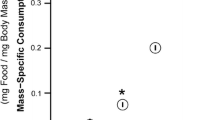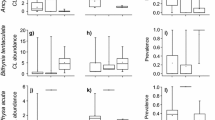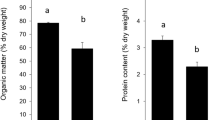Abstract
A total of 32 calcicolous lichen species, one alga and one bryophyte were recorded on a limestone wall in the grassland Great Alvar on the Baltic island of Öland, Sweden. Fourteen (41%) of these 34 species and free-living cyanobacteria showed herbivore damage, most probably due to grazing by the land snails Chondrina clienta and Balea perversa which inhabited the limestone wall. Three laboratory experiments were conducted to examine the food preferences of individuals of C. clienta and B. perversa collected at this site and to evaluate any association between their preference and the net food quality of the lichens to the snails. Chondrina clienta and B. perversa exhibited food preferences, which differed significantly between species. Within species, variation in food choice was similar among individuals. This indicates that snail populations may be composed of polyphagous individuals with similar food preferences. Different lichen species were of different net food quality to the snails as indicated by growth rate differences. In both snail species the most preferred lichen species of the choice experiment caused the largest weight increase in juveniles, viz. Caloplaca flavovirescens for C. clienta and Aspicilia calcarea for B. perversa. This suggest that the snail species studied differ in their abilities to deal with secondary compounds and physical characteristics of certain lichens or that they can utilize the energy and nutrients of these lichens to a different extent. It is suggested that differential food preferences might reduce the intensity of interspecific competition for resources (lichens) between C. clienta and B. perversa.
Similar content being viewed by others
References
Armaleo D (1993) Why do lichens make secondary products? In: Furuya M (ed) XV International Botanical Congress, Yokohama, Japan, 1993, Abstract pp 11
Arup U, Ekman S, Lindblom L, Mattsson J-E (1993) High performance thin layer chromatography (HPTLC) an improved technique for screening lichen substances. Lichenologist 25: 61–71
Baur A (1990) Intra- and interspecific influences on age at first reproduction and fecundity in the land snail Balea perversa. Oikos 57: 333–337
Baur A, Baur B, Fröberg L (1992) The effect of lichen diet on growth rate in the rock-dwelling land snails Chondrina clienta (Westerlund) and Balea perversa (Linnaueus). J Moll Stud 58: 345–347
Baur B (1987) Richness of land snail species under isolated stones in a karst area on Öland, Sweden. Basteria 51: 129–133
Baur B (1988) Microgeographical variation in shell size of the land snail Chondrina clienta. Biol J Linn Soc 35: 247–259
Baur B, Baur A (1990) Experimental evidence for intra- and inter-specific competition in two species of rock-dwelling land snails. J Anim Ecol 59: 301–315
Bernays E, Graham M (1988) On the evolution of host specificity in phytophagous arthropods. Ecology 69: 886–892
Breure ASH, Gittenberger E (1982) The rock-scraping radula, a striking case of convergence (Mollusca). Neth J Zool 32: 307–312
Coker PD (1967) Damage to lichens by gastropods. Lichenologist 3: 428–429
Culberson CE (1969) Chemical and botanical guide to lichen products. The University of North Carolina Press, Chapel Hill
Freeland WJ (1991) Plant secondary metabolites: biochemical coevolution with herbivores. In: Palo TR, Robbins CT (eds) Plant chemical defences against mammalian herbivores. CRC Press, Boca Raton, pp 61–81
Freeland WJ, Janzen DH (1974) Strategies in herbivory by mammals: the role of plant secondary compounds. Am Nat 108: 269–289
Fröberg L (1988) Calcicolous lichens and their ecological preferences on the Great Alvar of Öland. Acta Phytogeog Suec 76: 47–52
Fröberg L (1989) The calcicolous lichens on the Great Alvar of öland, Sweden. Ph D Thesis, University of Lund
Fröberg L, Baur A, Baur B (1993) Differential herbivore damage to calcicolous lichens by snails. Lichenologist 25: 83–95
Frömming E (1954) Biologie der mitteleuropäischen Landgastropoden. Duncker und Humblot, Berlin
Gerson U (1973) Lichen-arthropod associations. Lichenologist 5: 434–443
Hurlbert SH (1984) Pseudoreplication and the design of ecological field experiments. Ecol Monogr 54: 187–211
Kerney MP, Cameron RAD (1979) A field guide to the land snails of Britain and North-west Europe. Collins, London
Kitting CL (1980) Herbivore-plant interactions of individual limpets maintaining a mixed diet of intertidal marine algae. Ecol Monogr 50: 527–550
Lawrey JD (1980) Correlations between lichen secondary chemistry and grazing activity by Pallifera varia. Bryologist 83: 328–334
Lawrey JD (1983a) Lichen herbivore preference: a test of two hypotheses. Am J Bot 70: 1188–1194
Lawrey JD (1983b) Vulpinic and pinastric acids as lichen antiherbivore compounds: contrary evidence. Bryologist 86: 365–369
Lawrey JD (1984) Biology of lichenized fungi. Praeger, New York
Neuckel W (1981) Zu Aktivitätsregelung und Wasserhaushalt von Chondrina avenacea (Bruguière 1792), einer Felsen bewohnenden Landlungenschnecke. Ph D Thesis, University of Basel
Palmer AR (1983) Growth rate as a measure of food value in thaidid gastropods: assumptions and implications for prey morphology and distribution. J Exp Mar Biol Ecol 73: 95–124
Peake JF, James PW (1967) Lichens and Mollusca. Lichenologist 3:425–428
Pennings SC, Paul VJ (1992) Effect of plant toughness, calcification, and chemistry on herbivory by Dolabella auricularia. Ecology 73:1606–1619
Pfleiderer J, Winkler S (1991) Beziehungen zwischen Krustenflechten und Schnecken auf Kalkfelsen im Ulmer Raum. Jh Ges Naturkde Württemberg 146:89–113
Plitt CC (1934) A lichen-eating snail. Bryologist 37: 102–104
Rosén E (1982) Vegetation development and sheep grazing in limestone grasslands of south Öland, Sweden. Acta Phytogeogr Suec 72: 1–108
Santesson J (1970) Anthraquinones in Caloplaca. Phytochemistry 9: 2149–2166
Santesson R (1993) The lichens and lichenicolous fungi of Sweden and Norway. SBT-förlaget, Lund
SAS Institute (1990) SAS User's Guide: Statistics, 1990 edition. SAS Institute, Cary, North Carolina
Schmid G (1929) Endolithische Kalkflechten und Schneckenfrass. Biol Zentralbl 49: 28–35
Schultz JC (1988) Many factors influence the evolution of herbivore diets, but plant chemistry is central. Ecology 69: 896–897
Speiser B, Rowell-Rahier M (1993) Does the land snail Arianta arbustorum prefer sequentially mixed over pure diets? Funct Ecol 7: 403–410
Stahl E (1904) Die Schutzmittel der Flechten gegen Tierfrass. Festschrift zum siebzigsten Geburtstag von Ernst Haeckel. Gustav Fischer, Jena, pp 357–375
Stearns SC (1992) The evolution of life histories. Oxford University Press, Oxford
Thompson JN (1988) Variation in preference and specificity in monophagous and oligophagous swallowtail butterflies. Evolution 42: 118–128
Waldén HW (1984) Sveriges landmollusker—en artlista med kommentarer. Fauna och flora 79: 29–43
Wareing DR (1993) Feeding history—a factor in determining food preferences in slugs. J Moll Stud 59: 366–368
Tom-Tov Y, Galun M (1971) Note on feeding habits of the desert snail Sphincterochila boissieri Charpentier and Trochoidea (Xerocrassa) seetzeni Charpentier. Veliger 14: 86–88
Zopf W (1896) Zur biologischen Bedeutung der Flechtensäuren. Biol Zentralbl 16: 593–610
Zukal H (1895) Morphologische und biologische Untersuchungen über die Flechten. II Abhandlung, Sitzungsber K Akad Wiss Math-Naturw CI 104: 1303–1395
Author information
Authors and Affiliations
Rights and permissions
About this article
Cite this article
Baur, A., Baur, B. & Fröberg, L. Herbivory on calcicolous lichens: different food preferences and growth rates in two co-existing land snails. Oecologia 98, 313–319 (1994). https://doi.org/10.1007/BF00324219
Received:
Accepted:
Issue Date:
DOI: https://doi.org/10.1007/BF00324219




